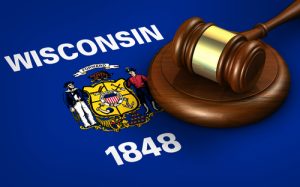With exceptions not relevant here, the omnibus statute, Wis. Stat. § 632.32, requires every motor vehicle insurance policy issued to an owner to provide that:
(a) Coverage provided to the named insured applies in the same manner and under the same provisions to any person using any motor vehicle described in the policy when the use is for purposes and in the manner described in the policy.
(b) Coverage extends to any person legally responsible for the use of the motor vehicle.
 Wis. Stat. § 632.32(3). In Thom v. 1st Auto Cas. Ins. Co., et al., No. 2020AP285, 2021 WL 1567752 (Wis. Ct. App. Apr. 22, 2021), the Wisconsin Court of Appeals was tasked with determining whether this provision multiplies policy limits for multiple insureds’ liability for use of a non-owned automobile not named in the policy, despite policy language to the contrary. The Wisconsin Court of Appeals held that Wis. Stat. § 632.32(3) did not supersede the policy language because the policy did not “describe” the vehicle in question, as required by Wis. Stat. § 632.32(3)(a).
Wis. Stat. § 632.32(3). In Thom v. 1st Auto Cas. Ins. Co., et al., No. 2020AP285, 2021 WL 1567752 (Wis. Ct. App. Apr. 22, 2021), the Wisconsin Court of Appeals was tasked with determining whether this provision multiplies policy limits for multiple insureds’ liability for use of a non-owned automobile not named in the policy, despite policy language to the contrary. The Wisconsin Court of Appeals held that Wis. Stat. § 632.32(3) did not supersede the policy language because the policy did not “describe” the vehicle in question, as required by Wis. Stat. § 632.32(3)(a).
A child was instructed by his uncle to operate his aunt’s Chevy Tahoe to the child’s grandparent’s house to help with farm work. In the process, the child negligently collided with the plaintiff’s vehicles, causing serious injuries. The plaintiff sued all the parties involved and their insurers under various theories of liability. As relevant to the issue on appeal, the plaintiff sued Rural Mutual Insurance Company, which issued a motor vehicle policy to the child’s father, for the negligence of the child, as well as the child’s mother and father for negligent supervision and control of the child.
There was no dispute that the child and his parents were all insured by the Rural Policy. However, the Rural policy’s limit of liability provision limited Rural’s liability to $300,000 for any one auto accident, regardless of how many insureds or claims are involved in the accident. However, the plaintiff argued that the omnibus statute supersedes the limit of liability provision, requiring Rural to provide a separate $300,000 limit to each of its three insureds. The circuit court determined that Rural’s maximum liability for this accident was $300,000, and the plaintiff appealed.
Under Wis. Stat. § 632.32(3)(a), “Coverage provided to the named insured applies in the same manner and under the same provisions to any person using any motor vehicle described in the policy when the use is for purposes and in the manner described in the policy.” The parties did not dispute that the child was using the Chevy for the purposes and in the manner described in the policy, so the sole issue was whether the Rural policy “described” the Chevy.
Under Wisconsin law, a vehicle is “described” by the policy if the vehicle is listed in the insurance application or policy declaration page, or if the vehicle is otherwise covered by the policy. Because the Chevy was not listed in the application or declaration page, the only way Rural’s limits could be multiplied would be if the Rural policy otherwise covered the Chevy.
The Court of Appeals determined that Rural need not provide separate policy limits to each of its insureds because the Rural policy did not otherwise cover the Chevy. The Rural policy defined “your covered auto” to include vehicles shown in the declaration, newly acquired autos, any trailer you own, or temporary auto or trailer substitutes for a vehicle described in the definition of “your covered auto.” The Chevy clearly did not fit any of these descriptions.
The plaintiff argued the Chevy was covered by the Rural policy through the definition of “insured”, which was, in part, “[The child’s parents] or any ‘family member’ for the ownership, maintenance or use of any auto or ‘trailer.’” The child was obviously a family member of his parents, so the plaintiff argued that any auto the child was driving is “covered” by the Rural policy.
The Court did not agree. It reasoned that the Rural policy’s distinction between “your covered auto” and “any auto” shows that the policy insures some people even when driving a vehicle that is not “covered.” The plaintiff’s interpretation would make any vehicle driven by any family member a “covered” auto under the Rural policy, an unreasonable interpretation.
The plaintiff also argued that Wis. Stat. § 632.32(3)(b), which extends coverage “to any person legally responsible for the use of the motor vehicle“ would permit coverage extension in this case because it is not limited to “any motor vehicle described in the policy” like subsection (a). However, the Court recognized that Mills v. Wisconsin Mutual Insurance Co., 145 Wis. 2d 472, 427 N.W.2d 397 (Ct. App. 1988), overruled on other grounds by West Bend Mutual Insurance Co. v. Playman, 171 Wis. 2d 37, 42-43, 489 N.W.2d 915 (1992), held that subsection (b) is referring to “the” vehicle described in subsection (a).
In sum, omnibus coverage extensions follow the vehicle, not the driver. Holding otherwise would extend coverage beyond the contemplation of both the Wisconsin legislature and motor vehicle insurers.
If you should have any questions regarding this article or subrogation in general, please contact Gary Wickert at gwickert@mwl-law.com.






